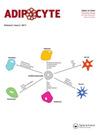应用生物信息学方法分析网膜前脂肪细胞和分化的白色脂肪细胞的不同特征
IF 3.5
4区 生物学
Q2 ENDOCRINOLOGY & METABOLISM
引用次数: 3
摘要
肥胖正在成为一个流行病学问题,与各种代谢相关疾病的发生和进展有关。肥胖的特征是白色脂肪扩张,同时伴随着白色脂肪细胞的肥大和增生。白色脂肪细胞增生被定义为脂肪形成,白色脂肪细胞的数量从前脂肪细胞增加。脂肪生成有助于将多余的甘油三酯分布在较小的新形成的脂肪细胞中,减少肥厚脂肪细胞的数量并分泌抗炎因子。因此,脂肪生成正在成为治疗肥胖的一个新的治疗靶点。在本研究中,为了更好地了解网膜分化白色脂肪细胞的改变对全身性代谢紊乱的贡献,我们从GEO数据库GSE1657下载了mRNA表达谱,在未分化前脂肪细胞(UNDIF)和网膜分化白色脂肪细胞(DIF)之间筛选了328个差异表达基因(deg)。通过基因本体(GO)分析、京都基因与基因组百科全书(KEGG)途径分析和蛋白质-蛋白质相互作用(PPI)网络,分别对上调和下调的deg对系统的贡献进行了分析。通过基因集富集分析(Gene Set Enrichment Analysis, GSEA),特别是GO分析、KEGG分析、hallmark分析、致癌分析和相关miRNA分析,探讨了整个改变基因在分化的白色脂肪细胞中的潜在贡献。目前的研究成果将为肥胖和肥胖相关疾病的治疗提供新的目标。本文章由计算机程序翻译,如有差异,请以英文原文为准。
Analysis of the different characteristics between omental preadipocytes and differentiated white adipocytes using bioinformatics methods
ABSTRACT Obesity is emerging as an epidemiological issue, being associated with the onset and progress of various metabolism-related disorders. Obesity is characterized by the white adipose expansion, which encounters white adipocyte hypertrophy and hyperplasia. White adipocyte hyperplasia is defined as adipogenesis with the increase in the number of the white adipocytes from the preadipocytes. Adipogenesis contributes to distributing excess triglycerides among the smaller newly formed adipocytes, reducing the number of hypertrophic adipocytes and secreting anti-inflammatory factor. Therefore, adipogenesis is emerging as a new therapeutic target for the treatment of obesity. In the present study, for a better understanding of the contribution of the alteration of the omental differentiated white adipocytes to the systemic metabolic disorders, we downloaded the mRNA expression profiles from GEO database GSE1657, 328 differentially expressed genes (DEGs) were screened between the undifferentiated preadipocytes (UNDIF) and omental differentiated white adipocytes (DIF). The contributions of the upregulated and downregulated DEGs to the system were performed via the Gene Ontology (GO) analysis, the Kyoto Encyclopedia of Genes and Genomes (KEGG) pathway analysis and Protein–Protein Interaction (PPI) network, respectively. The potential contribution of the whole altered genes in the differentiated white adipocytes was explored with the performance of Gene Set Enrichment Analysis (GSEA), especially on the GO analysis, KEGG analysis, hallmark analysis, oncogenic analysis and related miRNA analysis. The output of the current study will shed light on the new targets for the treatment of obesity and obesity-related disorders.
求助全文
通过发布文献求助,成功后即可免费获取论文全文。
去求助
来源期刊

Adipocyte
Medicine-Histology
CiteScore
6.50
自引率
3.00%
发文量
46
审稿时长
32 weeks
期刊介绍:
Adipocyte recognizes that the adipose tissue is the largest endocrine organ in the body, and explores the link between dysfunctional adipose tissue and the growing number of chronic diseases including diabetes, hypertension, cardiovascular disease and cancer. Historically, the primary function of the adipose tissue was limited to energy storage and thermoregulation. However, a plethora of research over the past 3 decades has recognized the dynamic role of the adipose tissue and its contribution to a variety of physiological processes including reproduction, angiogenesis, apoptosis, inflammation, blood pressure, coagulation, fibrinolysis, immunity and general metabolic homeostasis. The field of Adipose Tissue research has grown tremendously, and Adipocyte is the first international peer-reviewed journal of its kind providing a multi-disciplinary forum for research focusing exclusively on all aspects of adipose tissue physiology and pathophysiology. Adipocyte accepts high-profile submissions in basic, translational and clinical research.
 求助内容:
求助内容: 应助结果提醒方式:
应助结果提醒方式:


